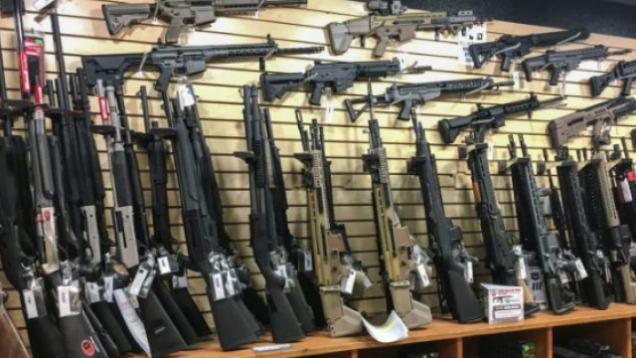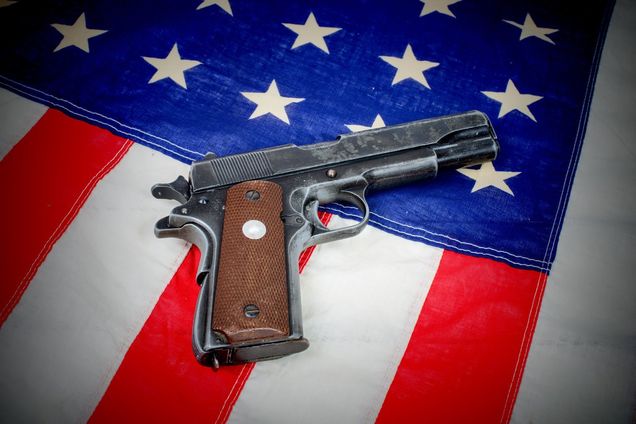Tagged: Parkland
Mental Illness and Gun Violence: What’s Really Responsible?
You’ve heard it all before. In fact, you’ve heard the same arguments repeated back and forth so many times you have memorized them yourself. The cycle goes like this: There’s a mass shooting, then in the tragic aftermath, the liberal and conservative pundits begin repeating their arguments left and right. Usually, on the conservative right there are calls for mental health reform and on the left, liberals agree that we need to address mental health, but point to gun access as the key issue to prevent these tragedies from happening. The rest of us, the general population, are left somewhere in between. We point fingers like everyone’s to blame, but we take action like nobody is responsible. That is to say, we take very little action at all.
Although this cycle has repeated itself to the point of feeling like a broken record, it’s important that we not get stuck like one. After all, the definition of insanity is doing the same thing over-and-over again while expecting a different result. Where some blame the mentally ill and some blame guns, it is important to step back and reframe our arguments to see the issue of gun violence in a different light. Maybe the solution, as is often the case, lies somewhere in between.
The tragedy in Parkland has energized this debate to unprecedented levels, but has also brought with it many familiar arguments. In particular, recent calls from President Trump to strengthen limitations on the ability of the mentally ill to access firearms gives us cause to reevaluate his premise that mental illness is associated with gun violence. President Trump’s critique is founded on a commonly shared belief among the majority of Americans. According to a Pew Research poll in 2017, 89% of people across the political spectrum favor placing increased restrictions on the ability of the mentally ill to purchase firearms. This commonly held belief across the political spectrum forces us to ask ourselves: What is the real relationship between mental illness and gun violence?
What do the Numbers Say?
The evidence suggests that we may be biased when it comes to our perceptions of the mentally ill and the potential for persons dealing with mental illnesses or disorders to exhibit violent tendencies. In fact, a 2013 national public opinion survey (p.367) found that 46% of Americans believe that persons with mental illness are “far more dangerous than the general population.” However, the public perspective is vastly distinct from reality. Another study (p.241) demonstrates that between 2001 and 2010, “fewer than 5% of the gun-related killings in the United States… were perpetuated by people diagnosed with mental illness.” People are far more likely to be killed by a person with a gun that does not have a mental illness, than someone that does have a mental illness.
While mental illness is not strongly correlated with gun violence, there are other conduct measures that appear to be strong predictors of such violence. Three conduct measures in particular that are powerful are past acts of violence/criminal history, a history of domestic violence, and substance abuse.
First, with regard to a history of violence, the American Psychology Association issued a report (see p.8) that concluded based on longitudinal studies, “The most consistent and powerful predictor of future violence is a history of violent behavior.” One article from Wisconsin Public Radio affirms this trend in reporting that for gun homicides in Milwaukee about, “93 percent of our suspects have an arrest history.” Although the Milwaukee sample is small and not entirely representative of the entire United States, such a high correlation is worthy of our attention in considering factors for reevaluating our gun policies.
Second, when it comes to the correlation between domestic violence and mass shootings or gun violence, the evidence is even stronger. According to a study quoted in the New Yorker, “Of mass shootings between 2009 and 2013, 57 percent involved offenders who shot an intimate partner and/or family member.” Further, a report from Everytown for Gun Safety shows that persons with a history of domestic violence account for “54 percent of mass shootings between 2009 and 2016.”
Third, with regard to substance abuse, a study (p.242) by Dr. Jonathan Metzl, an often quoted figure in studying the causes of gun violence in the United States, found that, “[A]lcohol and drug use increase the risk of violent crime by as much as 7-fold, even among persons with no history of mental illness.” According to the same study, “serious mental illness without substance abuse is ‘statistically unrelated’ to community violence.” In other words, substance abuse increases an individual risk of violence in general, including an increased risk of gun violence.
States Offer Pragmatic and Nuanced Solutions
However, correlation does not equal causation. Many of the current studies on the causes of gun violence and mass shootings face limits (p.240) in this particular regard. However, the low statistical correlation indicated in multiple studies between mental illness or disorders and gun violence are informative. The fact that there are other risk factors that are strong predictors of violence generally and gun violence specifically point to where our attention is likely better directed in trying to rework gun laws in a manner that will work for everyone.
The Giffords Law Center to Prevent Gun Violence points to one such unique legal mechanism adopted in Oregon, Washington and California, which have adopted laws for Extreme Risk Protection Orders (“ERPOs”). These laws allow family members or law enforcement officers to petition a court to keep guns away from someone going through a crisis. The laws are geared toward the principle that family members are best able to gauge changes in an individual’s behavior that could pose a serious risk of harm. Petitioners under these laws still have the burden of providing sufficient proof that the individual poses a risk of danger to themselves or others. ERPOs are also only temporary, but may vary in length. For longer protective orders, more compelling evidence must be offered that the person poses a risk of harm to themselves or others.
Oregon offers another pragmatic solution in its closing of the “domestic abuser loophole” through passage of a recent state law. Under the 1996 Domestic Violence Offender Gun Ban, domestic abusers are banned from owning or possessing a gun. However, the federal ban only applies to someone if they are married, living with, or have a child with the victim of the abuse. The wording of the law creates the “domestic abuser loophole,” which means that someone who is not living with their significant other and does not meet any of the other mentioned criteria, but who abuses their significant other, can still buy a gun. Oregon’s new law prohibits anyone convicted of a crime of domestic violence from owning or possessing a gun, regardless of whether or not that person lives with their significant other.
These new state laws are just examples of a number of other pragmatic and nuanced policy solutions that are geared toward preventing future gun violence while avoiding burdensome restrictions on the Second Amendment rights of the vast majority of Americans. Such solutions demonstrate our capacity to tackle the problem of gun violence in new and creative ways, while still preserving individual freedoms. Finally, these laws represent effective solutions that are based on empirical evidence about true risk factors for gun violence and not on ill-founded stigmas. A path forward on fixing our gun laws exists, but to move forward we must set aside our preconceived notions and work together to promote innovative solutions that protect both our rights and our safety.
 Nicholas Stone graduated from Boston University School of Law in May 2018 and plans to practice in Portland Oregon.
Nicholas Stone graduated from Boston University School of Law in May 2018 and plans to practice in Portland Oregon.
Whose Legislation is it, Anyway?
It seems that after every mass shooting, the gun control debate transforms into a discussion about mental illness. Was the shooter mentally ill? If so, some gun rights advocates will deflect from the issue of gun safety and argue for mental health reform while gun control activists will argue for stricter gun laws–specifically those that make it harder for people with mental illnesses to buy guns. The most recent Las Vegas and Parkland shootings are no different. Despite the copious research suggesting that the existence of a mental illness correlates much more strongly with suicide than it does with interpersonal crimes, mental illness is once again being deemed the culprit. Of note is Speaker Ryan’s call for mental health reform, which he described as a “critical ingredient” in preventing further mass shootings. Ryan was subsequently questioned as to whether he thought repealing the Social Security Rule (a rule that expanded background checks to include Social Security data on people with mental illnesses) was a mistake. When pressed on the issue, Ryan argued that the Obama administration rule was an infringement on Second Amendment rights. President Trump has also advocated more treatment for people with mental illnesses as a solution to gun violence.
Although some federal laws designed to prohibit gun access to citizens with mental illnesses exists, it is limited and under-enforced. Following the shooting at Virginia Tech, President Bush signed the NICS Improvement Amendments Act of 2007 into law, which attempted to identify individuals who are unqualified to possess guns due to mental illnesses or criminal backgrounds. This law proved to be inadequate; most notably when a mentally ill man, Adam Lanza, killed 20 first grade students and six teachers at Sandy Hook Elementary School in 2012. In response, President Obama proposed the Social Security Rule, which added more mental health records to the national background check system but was removed by Republicans in Congress under the Congressional Review Act in February of 2016.
limited and under-enforced. Following the shooting at Virginia Tech, President Bush signed the NICS Improvement Amendments Act of 2007 into law, which attempted to identify individuals who are unqualified to possess guns due to mental illnesses or criminal backgrounds. This law proved to be inadequate; most notably when a mentally ill man, Adam Lanza, killed 20 first grade students and six teachers at Sandy Hook Elementary School in 2012. In response, President Obama proposed the Social Security Rule, which added more mental health records to the national background check system but was removed by Republicans in Congress under the Congressional Review Act in February of 2016.
There is a wide political divide in the gun control arena, with 79% of Democrats agreeing with the statement “it is more important to control gun ownership than protect gun rights,” compared to only 9% of Republicans. In fact, this divide has widened substantially since 2012, when 62% of Democrats and 21% of Republicans agreed with the statement.
However, despite this deep division, the issue of gun restrictions for those with mental illness stands as a unique common ground. According to a Pew Research poll from June 2017, 89% of both Republicans and Democrats support restrictions that would prevent people diagnosed with a mental illness from purchasing guns. No other gun policy proposal was found to have the same kind of bipartisan support, though barring gun purchases by people on no-fly lists and background checks for private sales and at gun shows come close.
Even more striking is the support for preventing people with mental illnesses from obtaining guns among gun and non-gun owners. Again, there is wide agreement amongst the two groups: 89% of both gun owners and non-gun owners support this policy proposal. Again, there is no other policy proposal that garners the exact same support amongst gun-owners and non-gun owners. Moreover, 82% of those who say it is more important to protect gun rights rather than control gun ownership actually favor laws that prevent the mentally ill from buying guns, compared with 77% support amongst those who say it is more important to control gun ownership.
Given that the policy restricting access to guns for those with mental illnesses is so widely accepted amongst Democrats and Republicans, gun owners and non-gun owners alike, why don’t we have a more robust policy in place?
One hypothesis is the National Rifle Association’s opposition to this type of gun control proposals and their generous campaign contributions to Republican politicians. In the 2016 election cycle, the NRA gave over $77,000 to the Republican National Committee, and $838,215 to individual federal congressional candidates. In addition, the group spent over $30 million in support of Donald Trump’s presidential campaign, more than any other outside group, according to the Center for Responsive Politics. Opensecrets.com, a campaign finance accountability website, wrote that “[t]his election cycle, the NRA spent more than $52 million—a number that will rise as final campaign finance figures are tallied — to carry on its effort to increase Republican control of government.” In a news article following“The NRA, of course, was among the earliest and staunchest supporters of Trump’s presidential bid. We thank him for his quick action on this measure and look forward to working with him and the pro-gun majorities in Congress to protect Americans’ Second Amendment rights.” Trump responded at the NRA convention in April where he stated “You came through big for me, and I am going to come through for you.”
As it turns out, even NRA members support legislation that prevents those with mental illnesses from purchasing guns. A July 2017 Pew Research poll that controlled for partisanship found that 79% of Republican members of the NRA support this policy proposal. However, NRA members also report a general level of satisfaction with the organization’s political authority. Only 9% of NRA members say that the organization has too much influence over gun laws and about six in ten members say that they are satisfied with the amount of influence that the organization has over gun laws.
Thus, it seems the future for the gun debate may be determined not by the popularity of the ideas proposed, but by the strength of Americans’ allegiance to a very powerful group in Washington. Either that, or these ironies tainting the gun debate remain a mystery.
 Jessica Goldman anticipates graduating from Boston University School of Law in May, 2019.
Jessica Goldman anticipates graduating from Boston University School of Law in May, 2019.


